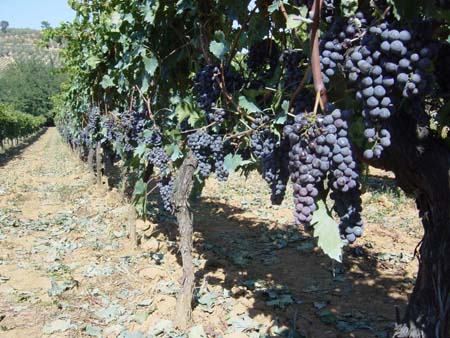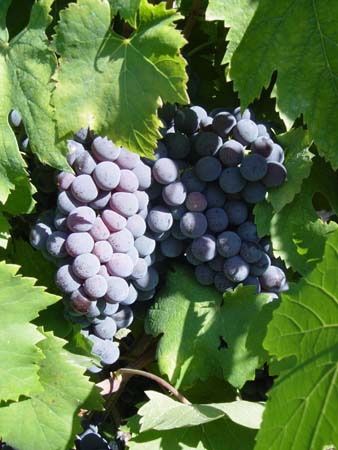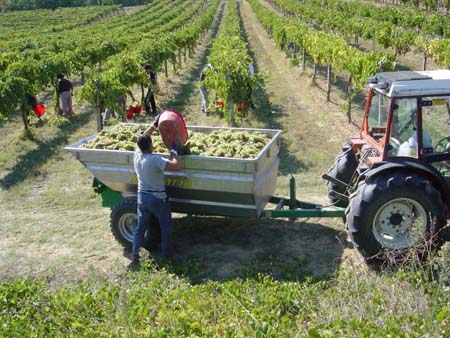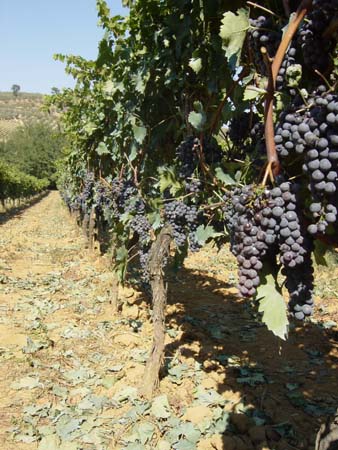DAVID'S DOWNLOADS
September 17 - WINE
Our stay here in Chianti has given me the opportunity to taste and learn
what true wine is all about. Before I had taken the time to explore the world
of wine, I believed that wine was simple and easily understandable. Now I
have discovered that wine is hardly simple, but extremely complex and head
spinning. I have also learned that tasting is only a small piece to the intricate
world of wine. Smelling the wine and being able to recognize even the slightest
scent of vanilla, fruit, licorice, or leather is just as important as tasting.
I am learning to tell the difference in color between different wines. There
are a great number of colors including granite, rose, and ruby. Although I
can't explain everything there is to know about wine, I can recapitulate what
a learned about the excellent red wine made right here in Chianti.
The Etruscans were the first to cultivate grapes in the Chianti region (9th century B.C.). They passed on much of their technology and culture, including harvesting grapes, to the early Romans. They trained their vines to grow up trees. The vines eventually would reach the very top of the trees and then produce grapes. The grapes turned out very acidic, because of lack of sunlight and nutrients (it was hard to get nutrients from the bottom of the tree to the top). When the grapes were pressed and wine was produced, the Etruscans had to add a lot of sugar, honey, and about 50% water. The wine was considered disgusting and undrinkable. Did you know that the grape vines in Italy are not really Italian vines? They are actually American! In the end of the 19th century, some unknown pest destroyed 90% of all vines in Italy. The new vines were exported from America, and have been of an American origin for about one hundred years!
The Chianti region is famous for its spectacular red wine. Although you
would expect to see vineyards full of red grapes, I have noticed that there
are almost as many white grapes as red. This puzzled me since we hadn't seen
many bottles of white wine in any store we had been in. I soon discovered
that most of the white grapes grown are used to produce mainly table and cooking
wine. Some of the grapes are also mixed in with the red wine. Did you know
what makes red wine red? I always thought that red grapes were not only red
on the outside, but also on the inside. This is completely false. The skins
of the red grapes are mixed into the wine to make it red. If the skins were
not added in, like white wine, it would turn out white since the inside is
clear. That is what makes one to two glasses of red wine a day good for your
heart!
There are many sets of regulations and standards that professional growers
must follow in order to be considered true Chianti wine. The two main sets
of rules are the D.O.C.G and the D.O.C. The D.O.C.G is a set of extremely
strict and prestigious regulations that only professional growers have the
capability of following. The D.O.C.G is the highest level of wine in Italy,
and represents genuine Chianti wine. D.O.C is not as harsh and prestigious.
The D.O.C.G monitors many factors such as the color, smell, and length of
aging. They are also very strict about the number of vines per hectare, space
between plants, and types of grapes used. 
The major type of grape used is called Sangiovese. The D.O.C.G states that 90% of all wine must be made with Sangiovese, although most growers use 100% Sangiovese. There are also different types of Chiantis, such as Chianti Classico (which I love!) and just Chianti. The Chianti Classico symbol of a black rooster is famous worldwide. Some people think that if Chianti wine doesn't have a black rooster on the label, it's not genuine. This is not true. The black rooster symbolizes a group of growers in Chianti who have agreed to work together. From there the wine can be reserve or non-reserve. The difference is that reserve usually ages for about five years, two or three years longer than non-reserve. Reserve is much stronger than non-reserve, and because of my love for light wines that slip down your throat like angel hair, I prefer non-reserve wines.
Grapes like a Mediterranean climate and normal weather patterns. This is what separates a good year from a bad. The quality greatly varies from year to year. The grapes won't be as good of quality if the weather is irregular. They like rain in spring, a hot, dry, and sunny summer, moderate rain in August, and a dry September. This year will be considered a bad one because of how hot and dry it has been. Grape vines can live up to 80 years old, and become as thick as a tree! Vines become mature after three years, which is when they can be harvested and pressed into wine (according to the D.O.C.G).
Tasting Chianti wine for the first time has been both adventurous and joyful. After learning so much on how to analyze wine and discover its characteristics, I feel like a wine child prodigy in restaurants.
